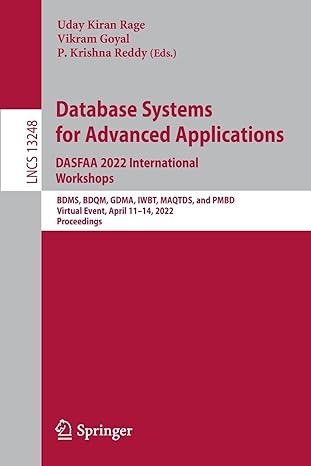Question
RPG Game Suppose that you are creating a fantasy role-playing game. In this game we have four different types of creatures: humans, cyberdemons, balrogs, and
RPG Game
Suppose that you are creating a fantasy role-playing game. In this game we have four different types of creatures: humans, cyberdemons, balrogs, and elves. To represent one of these creatures we might define a Creature class as follows:
class Creature
{
private:
int type; // 0 human, 1 cyberdemon, 2 balrog, 3 elf
int strength; // How much damage we can inflict
int hitpoints; // How much damage we can sustain
string getSpecies(); // Returns type of species
public:
Creature( );
// Initialize to human, 10 strength, 10 hit points
Creature(int newType, int newStrength, int newHit);
// Initialize creature to new type, strength, hit points
// Also add appropriate accessor and mutator functions
// for type, strength, and hit points
int getDamage();
// Returns amount of damage this creature
// inflicts in one round of combat
};
Here is an implementation of the getSpecies( ) function:
string Creature::getSpecies()
{
switch (type)
{
case 0: return "Human";
case 1: return "Cyberdemon";
case 2: return "Balrog";
case 3: return "Elf";
}
return "Unknown";
}
The getDamage( ) function outputs and returns the damage this creature can inflict in one round of combat. The rules for calculating the damage are as follows:
Every creature inflicts damage that is a random number r, where 0 < r <= strength.
Demons have a 5% chance of inflicting a demonic attack which is an additional 50 damage points. Balrogs and Cyberdemons are demons.
With a 10% chance elves inflict a magical attack that doubles the normal amount of damage.
Balrogs are very fast, so they get to attack twice.
An implementation of getDamage( ) is given below:
int Creature::getDamage()
{
int damage;
// All creatures inflict damage which is a
// random number up to their strength
damage = (rand() % strength) + 1;
cout << getSpecies() << " attacks for " <<
damage << " points!" << endl;
// Demons can inflict damage of 50 with a 5% chance
if ((type = 2) || (type == 1))
if ((rand() % 100) < 5)
{
damage = damage + 50;
cout << "Demonic attack inflicts 50 "
<< " additional damage points!" << endl;
}
// Elves inflict double magical damage with a 10% chance
if (type == 3)
{
if ((rand() % 10)==0)
{
cout << "Magical attack inflicts " << damage <<
" additional damage points!" << endl;
damage = damage * 2;
}
}
// Balrogs are so fast they get to attack twice
if (type == 2)
{
int damage2 = (rand() % strength) + 1;
cout << "Balrog speed attack inflicts " << damage2 <<
" additional damage points!" << endl;
damage = damage + damage2;
}
return damage;
}
One problem with this implementation is that it is unwieldy to add new creatures. Rewrite the class to use inheritance, which will eliminate the need for the variable type. The Creature class should be the base class. The classes Demon, Elf, and Human should be derived from Creature. The classes Cyberdemon and Balrog should be derived from Demon. You will need to rewrite the getSpecies( ) and getDamage( ) functions so they are appropriate for each class.
For example, the getDamage( ) function in each class should only compute the damage appropriate for that object. The total damage is then calculated by combining the results of getDamage( ) at each level of the inheritance hierarchy. As an example, invoking getDamage( ) for a Balrog object should invoke getDamage( ) for the Demon object which should invoke getDamage( ) for the Creature object. This will compute the basic damage that all creatures inflict, followed by the random 5% damage that demons inflict, followed by the double damage that balrogs inflict.
Also include mutator and accessor functions for the private variables. Write a main function that contains a driver to test your classes. It should create an object for each type of creature and repeatedly outputs the results of getDamage( ).
Then you must create one non-member function in your main program called battleArena(), that takes two Creature objects as input parameters. The function should calculate the damage done by creature1, subtract that amount from creature2s hit points, and vice versa. If both creatures end up with zero or less hit points then the battle is a tie. Otherwise, at the end of a round, if one creature has positive hit points but the other does not then the battle is over. The function should loop until the battle is either a tie or over.
Once complete, use this as a base for creating a game. You should add an additional creature which can be derived from any of the existing creatures (but it has to do different things) or you can create a weapons class and randomly pick up weapons and change the strength of your character or hit points by collecting them. Additionally, you need to use these in a game that you create. The creatures should interact, battle, or whatever you can think of. Be sure to include the rules of your game and the text based interface.
Step by Step Solution
There are 3 Steps involved in it
Step: 1

Get Instant Access to Expert-Tailored Solutions
See step-by-step solutions with expert insights and AI powered tools for academic success
Step: 2

Step: 3

Ace Your Homework with AI
Get the answers you need in no time with our AI-driven, step-by-step assistance
Get Started


